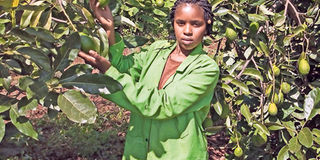Beware! This enemy of avocado will only show up after harvest

Lucy Ndung'u an avocado farmer based in Murang'a County. One of the biggest enemies of avocados is a disease called anthracnose. PHOTO | SAMMY WAWERU | NATION MEDIA GROUP
What you need to know:
- Avocados are commonly propagated from seeds. However, grafted seedlings are the most suitable for growing because they are resistant to pests and diseases and offer higher yields.
- Sometimes one may notice some parts on the leaves or the trees develop chlorotic and necrotic spots. Defoliation then takes place.
- The fungus easily affects fruit quality since the damaged areas of the avocados discolour and have a sour taste. Before harvesting, brown to black lesions develop around the lenticels of the infected fruits.
- Farmers and vendors should thus ensure that the fruits are placed in a cool and dry environment because low temperatures result in chilling injuries.
Avocado is the crop of the moment, with many people seeking to reap from the fruit, which fetches good prices in the export market.
While there are two varieties grown in the country, Hass and Fuerte, the former is the most popular.
Avocados are commonly propagated from seeds. However, grafted seedlings are the most suitable for growing because they are resistant to pests and diseases and offer higher yields. One of the biggest enemies of avocados is a disease called anthracnose.
This disease makes the fruits rot or end up with a very bitter taste. It is not easy to notice it since the fruit’s skin is usually black or brown when ripe.
Infection of the fruit can take place at any time after fruit-set but the damage does not show up until after picking, during post-harvest storage and marketing. Anthracnose can affect the plants at any stage of their growth.
Sometimes one may notice some parts on the leaves or the trees develop chlorotic and necrotic spots. Defoliation then takes place.
The fruits suddenly develop small dark spots that rapidly expand in two to three days as the fruit ripens.
The skin of immature avocado is less protective against anthracnose infection, which means one could unknowingly have a bad case of the infection. Anthracnose is spread by rain splash, high moisture and warm temperatures.
FRUIT CONTAMINATION AND INJURIES
The fungus easily affects fruit quality since the damaged areas of the avocados discolour and have a sour taste. Before harvesting, brown to black lesions develop around the lenticels of the infected fruits.
One can easily overlook the lesions since they do not fully enlarge in the fruits until ripening takes place.
The large lesions occur on avocados when the infected fruits are injured by insects or through mechanical wind rubbing.
The lesions become thicker and sunken upon ripening. Cut fruits usually have extended rotting which appears to be hemispherical.
The disease then becomes a post-harvest challenge especially when the avocados have been placed in a cold environment. To detect the disease, cut some pieces of the fruit and sample before selling the product.
Farmers and vendors should thus ensure that the fruits are placed in a cool and dry environment because low temperatures result in chilling injuries. Therefore, good pre-harvest and post-harvesting practices effectively control the disease.
Prune dead limbs and twigs to prevent the spread of the disease. This also reduces humidity within the canopies by improving air circulation.
Spray the tree with copper fungicide every two weeks after blossom to ensure that your fruit is protected throughout its development. Crop residues should be properly disposed of to avoid spreading the disease.
Pruning and harvesting should be done only during dry conditions to minimise fruit contamination and injuries. The fruits should also be marketed rapidly.





